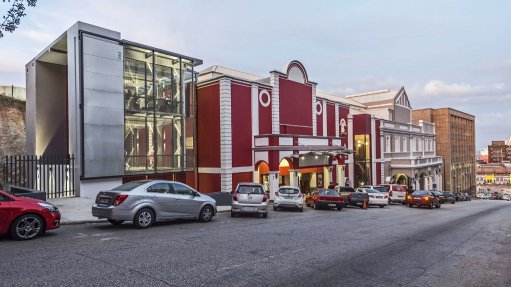
HERITAGE SITE The Opera House upgrades included the use of stainless steel, which created a distinctly contemporary and elegant architectural expression to the foyer extension
Since the completion of upgrades to the Opera House in Port Elizabeth – a 2016 Southern Africa Stainless Steel Development Association Awards finalist in the architecture building and construction category – it has become a significant tourist attraction, architecture company The Matrix Urban Designers & Architects architect Tony Danev tells Engineering News.
“The idea for the Opera House, the southern hemisphere’s oldest operating theatre, was to adopt a contemporary approach to each of the intended new additions, with a clear aim to use stainless steel as a material for upgrading the building,” he says.
Stainless steel – extensively used in various forms throughout the project, such as in cladding and glass bridges of the building – offers a high-quality, contemporary finish, he explains.
“Using stainless steel also highlighted the new contemporary interventions, showcasing a bold and innovative approach to restoration,” says Danev.
He states that the stainless steel used in, for example, a section of the building called “the curtain”, which is an extension of the building’s foyer, creates a distinctly contemporary and elegant architectural statement. “This resulted in a background building subservient to the original historical building, yet one distinctly contemporary.”
Danev says the curtain offers an elegant visual filter during the day, revealing an illuminated interior at night – serving as a “modern curtain” – and was manufactured by German engineering company GKD Metal Fabrics.
With the fluctuating rand exchange rate, the screen was ordered in advance, he adds.
It had to be precut to size and shipped to South Africa in the form of panels. “Having the screen shipped in the form of panels placed significant pressure on the main contractor, construction company GVK-Siya Zama Construction, which had to ensure minimal tolerances on the façade,” Danev states.
Stainless steel panels were also used for the internal wall cladding of the Opera House project.
“The stainless steel cladding highlights particular spaces in the building and offers a contrast between new and old sections,” he mentions.
Meanwhile, Danev notes the use of stainless steel around a purpose-made stained glass window in the building’s foyer, which was specifically installed to commemorate three South African “local theatre greats” – playwright, novelist, actor and director Athol Fugard, playwright and actor Winston Ntshona and actor and writer John Kani.
The upgraded Opera House’s stainless steel glass bridges are made of glass panel flooring and links the extended foyer section to the existing building.
“Intentional misalignment in floor levels between the two spaces articulates the stainless steel bridges as contemporary elements,” Danev says.
He adds that the entrance canopy “denotes the final touch of stainless steel”, further describing it as an “elegantly curved structure”.
According to Danev, a second phase of the project is expected to start in the “near future”, encompassing the addition of a restaurant, a theatre for drama schools, a stage-set manufacturing workshop and an extension to the main stage.
“The Opera House is a public building of importance to locals, attracts tourists and serves the greater needs of the community,” he says.
The cost of the project’s first phase, funded by the Department of Arts and Culture, was about R27.5-million, with stainless steel costs amounting to about R750 000 of this total.
The Opera House project also included the refurbishment of the cabaret theatre, also known as The Barn, and the main theatre, renovations to the existing foyer, with additional damp and damage repairs, the upgrade of staff offices, carpet and wallpaper replacements, and compliance to National Building Regulations regarding access for disabled persons, besides others.
The Port Elizabeth Opera House board had decided in 2011 to rationalise circulation through the Opera House by improving access to the building through renovating and extending the cabaret theatre.
In the same year, Matrix Urban Designers & Architects was appointed to facilitate the project, conceptualise the design brief and oversee the implementation of the project.
Heritage Site
The Opera House in Port Elizabeth was built in 1892. As a source of light, candles had been used before gas lighting was introduced 16 years later. When the theatre opened, it was recognised and described as “The finest theatre in all the World” – the fact that the building is still used today serves as testament to its stature.